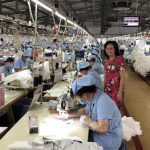 According to forecasts and analysis from the Vietnam Textile and Apparel Association (Vitas), the textile and garment industry will recover and flourish at the latest in quarter 4-2020. Many textile enterprises expect the market to grow again in the third and fourth quarters. However, back to companies at this time, we note that the business and production situation is still heavily affected. Covid-19 translation. Enterprises, especially small and medium enterprises are increasingly shrinking production, resisting processing each small order to pay wages for the few workers who are retained to wait for future orders.
According to forecasts and analysis from the Vietnam Textile and Apparel Association (Vitas), the textile and garment industry will recover and flourish at the latest in quarter 4-2020. Many textile enterprises expect the market to grow again in the third and fourth quarters. However, back to companies at this time, we note that the business and production situation is still heavily affected. Covid-19 translation. Enterprises, especially small and medium enterprises are increasingly shrinking production, resisting processing each small order to pay wages for the few workers who are retained to wait for future orders.
At Phu Thanh Nam Garment Company Limited (District 12), a few months ago there were still over 400 bustling workers on shift, now only 1/3. “At the time of the outbreak, the company’s US and European customers were suspended, pledging to re-sign orders and pay off debts in August and September. But now, they announced that customers are still have not paid yet, so they continue to plead for debt, and for information about the re-signing of the order, the appointment will last December. Currently, the company has closed 2 out of 3 factories to maintain production about 40% in order to have jobs for workers and wait and see the situation ”, the leader of Phu Thanh Nam Garment Company Limited said. Similarly, the director of Line Style Garment Company Limited (Hoc Mon District), Mr. Nguyen Van Chien shared: “We are currently facing a lot of difficulties due to a shortage of orders. Being a small company specializing in manufacturing dresses and dresses to Japan, due to the influence of the translation, customers are in debt of more than 10 billion and have not yet recovered. To maintain operations, the company must receive back the orders from other businesses to share; accept the low processing price, before 1 USD for a product, now the customer is pressed for 0.5 USD, but still have to do to pay the workers. The workers have followed me for many years, but now I have difficulty leaving it hard ”.
Not only small and medium businesses “eat with” each meal, a number of large companies are no exception. Representatives of Garment Corporation 10 said that from March until now, large orders have been severely reduced. It is currently the season for making goods for autumn, winter, Christmas, and New Year, but in the top markets in the import of textiles and clothing such as the United States, Europe … the atmosphere is very bleak, the transaction is almost stopped. Orders for the main items of May 10 in recent years such as suits, shirts, trousers and office fashion products have been sharply reduced, from 40-60%. Viet Tien Garment Joint Stock Company also reported a decrease of 40% in Q2 profit, to only VND 52.5 billion. Not to mention, many customers also apply for begging, making it more difficult for production enterprises.
Leverage from the domestic market
According to the Ministry of Industry and Trade, up to now, only a few businesses have received about 50-60% of orders for September, October, the rest of 2020 and 2021 have not had clear information. . The reason is that the purchasing power of consumer goods in the US, Europe and Japan markets has not shown many good signals. The garment import figures and a series of price cuts stimulates demand, pushes inventories away to avoid backlog of retail capital; The temporary suspension of garment imports by major importers shows that the market as well as the demand for clothing products is slowing down. This is also the reason for the first 9 months of 2020, Vietnam’s textile and garment industry exported only 25.5 billion USD, down 12% over the same period. Vitas President Vu Duc Giang predicted that the textile and garment industry’s export turnover in 2020 will reach the highest of about 34 billion USD.
Facing the current situation, to compensate for the shortage of orders in the international market, representatives of Vitas as well as experts said that textile enterprises need to promote exploitation of the domestic market. Because, the domestic market with nearly 100 million people is always rich in potential, well exploited will create leverage for the textile industry to overcome the crisis. Besides, it is necessary to minimize the decrease in revenue and profitability by managing production costs and keeping product quality. In the long term, to improve the efficiency of the textile and garment industry, the solution is to promote chain linkage, reduce dependence on countries supplying raw materials and accessories, and at the same time meet the origin requirements of the CPTPP, EVFTA Agreement … exploit the advantages of trade agreements. However, for effective implementation, the role of the Government in planning development is needed.
Source: SGGP, Vietnam






